
 |
|
|
The Call of the Wild: Backstory
Washington Post, Sunday, 9/13/1992
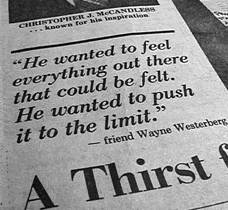 The Post follow-up stroy (9/22/1992)
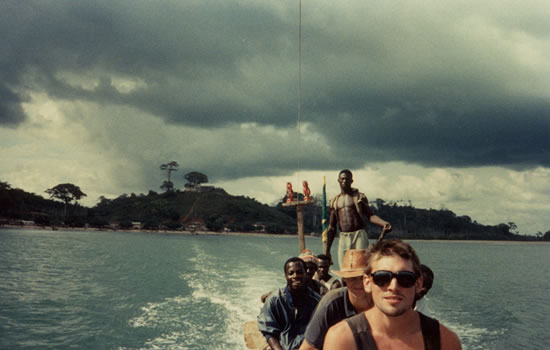 The types of decisions you make at 22
The funny thing is, I wasn't the only one who had this reaction, and the story was well known among my generation for years before the book Into the Wild came out. A lot of us read about it in the Post, or The New York Times, or People magazine, and some of us caught the more detailed articles in Outside magazine ("Death of an Innocent," Jon Krakauer, January 1993), or more likely, in The New Yorker ("I Now Walk Into the Wild," Chip Brown, February 1993). Whatever the case, I distinctly remember that my circle of friends used to reference Chris all the time back in the early nineties. Whether it was over late night beers at Hawk 'n' Dove or the Tune Inn on Pennsylvania Avenue, or the random Monday night when my sister would come over our place to watch Northern Exposure, the story of Chris McCandless lived on well after he'd been forgotten by the media. In some ways, he had become a true Gen-X cult figure: if you asked a twenty-something in the early 1990s if they'd ever heard of Chris McCandless, or the guy who took the rice and the books out into the woods of Alaska, odds are they would know exactly whom you were talking about, and had a rather romantic view of him; whereas most of our parents' generation had never heard of him, and if they did, thought him foolish and more a tragic figure than a romantic one. I remember wondering, even back then, if I could somehow, someday, make a pilgrimage up to Alaska, and make my way out to the bus where he lived, and died, that summer of 1992.
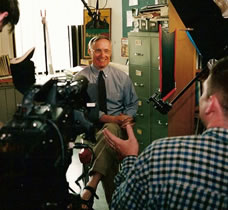 Production on The Political Dr. Seuss
kept me busy for a few years Years passed. I went back to school for my Master's degree, got married, had my first child, made another film, had a second child, moved a couple times. And in the meantime, twice, I actually tried to make the film. The first time was in the summer of 2002. In the planning stages, I wrote a letter to Jon Krakauer asking him for advice: Dear Mr. Krakauer:I was born in 1968. This fact might seem insignificant, but it has everything to do with why I've never been able to let go of the Chris McCandless story...What I hope to achieve is a film that is thoughtful, meditative, complex, undramatic, symbolic, and reflexive—an exploration into who Chris McCandless was, and what he has come to represent, both to his own generation and across generations...Although I hope to retrace his journeys this summer, I have yet to commit myself entirely, and would like to correspond with you and/or Walter and Billie McCandless before making a final decision. I would hope to have the opportunity at some point, as you did in writing the book, to earn their trust, and likewise, to allow them, should they desire it, access to my film in all its stages... A day or so later the phone rang, and much to my surprise, it was Jon Krakauer on the line. He told me that not only was I not the first person to have the idea of making a film on the McCandless story, but that so many people had approached the McCandlesses about a film since Into the Wild was published, that by now their "eyes glazed over" with every new proposal. Subsequently, Jon had fallen into the role of contact person for the family, receiving myriad letters about possible films, and sending them all along to the McCandlesses for evaluation, and all of them, for ultimate rejection. He said that he liked my idea, and my approach to the subject, but added that there was little chance the McCandlesses would give my letter serious consideration. Indeed, they had decided, definitively, that there would never be a film made about Chris. They were happy with his book. Why risk a bad movie? Krakauer went on to tell me that a movie had actually been in the works a year or so earlier. It was to be directed by Sean Penn, and was to star the new "it boy" at the time, Leonardo DeCaprio, as Chris; I was told that Marlon Brando was even slated to make a cameo as Ronald Franz (Hal Holbrook's role). But, Krakauer went on, the night before all the papers were going to be signed, Chris's mother had a nightmare, and the next morning the McCandless family pulled the plug on the whole deal, deciding right then and there that no movie would ever be made—not Sean Penn's, or anyone else's. 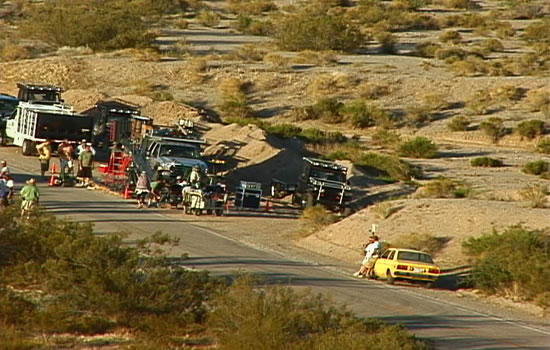 Sean Penn�s Into the Wild crew at the Detrital Wash, Arizona
Krakauer went on to suggest, quite genuinely so it seemed at the time, that I make another documentary, chose another story, "that there are lots of other great ones to tell." Well, that phone call, taken alongside my deteriorating financial state and some familial concerns, put the brakes on the documentary for the summer of 2002. Before I set off in the footsteps of McCandless, I needed to first figure out if I could still make the film without the participation of Jon Krakauer or the family. Well, another year passed, and by the summer of 2003, after a great deal of thought and consideration, and another fruitless series of letters to the McCandlesses, I nonetheless concluded that I still wanted to make the film, and had little choice but to do it on my own. Once again, I began planning my itinerary. Of course, the best laid schemes of mice and men, as they say, often go astray, and so did mine. Karen and I were planning on moving to Boston at the end of the summer, once I got back from Alaska, but because we couldn't work out an extra month on our lease without signing on for another year, we had to move mid-summer, undermining my entire production schedule. Anyway, the upshot of it was that another summer passed with no McCandless film. And, with my Dr. Seuss film in full swing in 2004, another summer after that. The following year, too, passed without a film, as my wife's job took us out of the country, and my Ph.D. comps consumed me. Well, I passed my exams, got my dissertation prospectus approved and filed, and I even got a co-production offer from WETA to move forward with my documentary about the history of college football. But there was still Chris McCandless, and the film I needed to get out of my system.
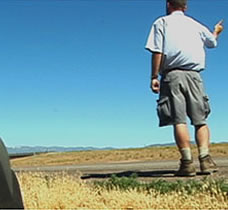 Hitchhiking in Utah
In any case, sometime in later 2005, around the holidays, I decided once and for all that I was going to shoot the documentary the following summer, heading out once my BU commitments were done. I once again started to move forward with my production plans, this time for May 2006, still feeling a bit ambivalent about the whole thing, but confident that it was something I still needed to do. And then in March, on a whim, I did the following Google search: "Chris McCandless film." Needless to say, I was utterly shocked to see the first page of results, and discover that Sean Penn was making his film after all. I clicked on the one of the top handful of hits, an article from Variety: "Par 'Wild' About Penn." I couldn't believe my eyes. I was devastated. After mustering up all my energies to finally commit to making the film that summer, I felt like the rug had been pulled out from under me. My immediate thought was: Well, that's it, I waited too long and now I've blown it. I mean, how do you compete with the resources of Paramount? This was now going to be the Chris McCandless film, and I would have to live with that fact. Not a pleasant realization. For two days I felt a sense of loss, and in a way came to realize how badly I had still wanted to make the film, and go through it all, even at thirty-seven.
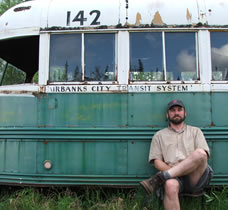 Arrival at Fairbanks 142
And so, for anyone who hasn't already stopped reading this seemingly endless and rather self-indulgent essay of one man's filmmaking odyssey, that's the backstory of The Call of the Wild. Ron Lamothe |